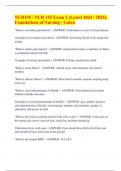NUR155 / NUR 155 Exam 2 (Latest ):
Foundations of Nursing - Galen
What is secondary prevention? - ANSWER -Undertaken in cases of latent disease
Example of secondary prevention - ANSWER -Screening, blood work, diagnostic
testing
What is tertiary prevention? - ANSWER -implemented when a condition or illness
is permanent and irreversible
Example of tertiary prevention - ANSWER -Chemo, medication, rehab
What is acute illness? - ANSWER -Abrupt onset, short duration (less than 6
months)
What is chronic illness? - ANSWER -More than 6 months, requires ongoing long-
term care
What is social determinants of Health? - ANSWER -Non-medical factors that
influence health outcomes.
Examples of social determinants of health? - ANSWER -Age, gender, genetics
and inherited traits, lifestyle, environment, attitudes and emotions, quality of
education, and access to food
What is the correct a patient should walk with a cane? - ANSWER -Cane goes on
the strong side, move cane out first, weak leg, and then strong leg
Education for pt. with cane - ANSWER -Cane should be at the level of hip, and
arm should be bent, don't look at the ground
What is the normal BMI? - ANSWER -18.5-24.9
, What are Simple carbohydrates? - ANSWER -fast acting sugar, starch and fiber.
What are examples of simple carbohydrates? - ANSWER -fruit, milk, table sugars,
raisins
What are complex carbohydrates? - ANSWER -slow acting sugar, starch and
fiber.
What are examples of complex carbohydrates? - ANSWER -pasta, bread, peas,
lentil, grains
What does pre-albumin and albumin indicate? - ANSWER -mal-nutrition
Iron - ANSWER -green leafy vegetables and animal meat
Calcium - ANSWER -milk, mild product, tofu, soy products, green leafy
vegetables
Phosphorus - ANSWER -dairy beans and meats
Vitamin C - ANSWER -citrus fruit, broccoli, brussel sprouts, tomatoes,
Potassium - ANSWER -bananas, avocado, sweet potatoes, white beans
Proteins - ANSWER -Lean meats, eggs, dairy, seeds and nuts, beans, and legumes
and soy
Vitamin A - ANSWER -carrots, green leafy vegetables
What are vegan at risk for? - ANSWER -protein and calcium deficiency
What places people at a higher risk for nutritional deficiency? - ANSWER -
Elderly patients, economic statues, religion, disease, diets, social factors,
environment, mental health issues, dental issues, difficult swallowing or pain
swallowing




